有效整体语言教学策略
小学语文课题研究:小学语文单元整体教学策略的实践研究

小学语文单元整体教学策略的实践研究一、研究背景和意义(一)研究背景随着教育部《中国学生发展核心素养》文件的正式发布,中国教育正式迈入了核心素养的新时代,教育改革也从“知识本位”迈向“素养本位”,发展学生核心素养成为教育改革发展的趋势。
2022年国家进一步修订了《课程方案》和《义务教育语文课程标准》(以下简称“新课标”)。
课程方案指出:“探索大单元教学、积极开展主题化、项目式学习等综合性教学活动,促进学生举一反三、融会贯通,加强知识间内在关联,促进知识结构化。
”面对全新的教育形式与教学要求,引发了教育界对教学模式的深度思考,加快了教学转型的步伐。
新课标的颁布也引领着教育教学观念的变革,强调培养“学生的思维发展、问题解决能力、创新意识、创新精神、科学态度、科学思维等在不同学段的表征”,突出学习情境创设和学习任务设计的重要性,落实了素养导向的“教学评”一体化,从而发挥课标的育人价值。
紧跟教育改革的是教材的不断升级,在统编版小学语文教材的编排中,单元主题鲜明而具体,课文之间的联系也越来越紧密,这向我们传递着单元整合的理念,同时也要求教师要从传统的零散教学模式,走向更加注重知识技能融会贯通的单元整体教学。
教师要以单元整体为引领,将相关知识和概念有机地连接起来,构建一个具有内在联系的教学框架,围绕一个共同目标组织学习内容、过程和评价,这种结构化的设计可以帮助学生更好地理解知识之间的关联,为学生提供更为综合、有意义的学习体验。
1.存在问题课题组通过调研、教师访谈,发现很多教师在单元整体教学实施的过程中存在以下问题:(1)学习情境的创设不符合学习需求。
情境未能源于学生的真实需求而创设,部分教师出现为“情境”而创设“情境”的现象,存在牵强附会的误区;情境创设的作用仅限于营造氛围,未能贯穿整个学习过程,与学习任务相分离。
(2)学习目标、内容、资源等要素缺乏整合。
语文学科的单元教材内容较多,知识点庞杂,教师在进行单元整体教学中,缺乏具体详实的操作路径,并且语文学科单篇教学经验丰富,教师不能很好地根据学生的学习需求处理好单篇与单元的关系,导致教学内容碎片化。
提高初中语文课堂教学有效性的策略

提高初中语文课堂教学有效性的策略初中语文课程作为学生语言表达和思维能力的基础,是学生学习过程中重要的一环。
提高初中语文课堂教学的有效性,不仅关乎学生的学习效果,也关乎教师的教学质量和学校的教学成绩。
采取一些策略来提高初中语文课堂教学的有效性十分重要。
本文将从多种角度提出一些策略,以帮助语文教师更好地进行课堂教学。
一、激发学生学习兴趣激发学生学习兴趣是提高课堂教学有效性的重要方面。
语文教学内容丰富多样,但学生对于文学作品的兴趣并不一定都很浓厚。
教师需要通过多种方式来激发学生的学习兴趣。
可以通过生动的故事、趣味的游戏和视频等形式来吸引学生,让他们在课堂上保持高度的专注和积极的参与度。
教师还可以结合学生的实际情况,引导学生去发现文字背后的故事,让学生在阅读中产生共鸣和情感,从而激发学生的学习兴趣。
二、注重多媒体辅助教学多媒体辅助教学是提高初中语文课堂教学有效性的重要手段之一。
通过使用多媒体设备,可以将书本中的文字图像化,使学生更容易理解和接受。
通过幻灯片展示文学作品的背景和作者的生平,通过音频播放优美的文章朗读,通过视频展示相关的时代背景等,都可以使学生对于语文内容有更加直观的认识和理解。
采用多媒体辅助教学还可以增加课堂的生动性和趣味性,使学生在学习中更加主动和积极。
三、注重启发思维引导语文教学不仅是知识的传递,更重要的是培养学生的思维能力和表达能力。
教师在课堂教学中应该注重启发思维引导学生。
在讲解文学作品时,教师可以提出一些引导性的问题,让学生在阅读中产生自己的理解和感悟;在写作指导中,教师可以引导学生从多个方面思考问题,帮助他们构建自己的逻辑和表达方式。
通过启发思维引导,可以使学生在学习中形成自主思考和表达的能力,从而提高课堂教学的有效性。
四、提供个性化的学习辅导在初中语文课堂教学中,由于学生的学习能力和兴趣差异很大,因此教师需要提供个性化的学习辅导。
对于学习能力较高的学生,教师可以提供更加深入和拓展的内容,让他们接触更多类型和形式的文学作品;对于学习能力较弱的学生,教师可以给予更多的帮助和引导,让他们在学习中找到适合自己的方法和途径。
初中英语单元整体教学的有效路径

初中英语单元整体教学的有效路径在初中英语教学中,单元整体教学是一种能够提升教学效果、促进学生综合语言运用能力发展的重要方法。
它打破了传统的以单课为单位的教学模式,将一个单元视为一个整体,从整体的角度出发设计教学目标、安排教学内容、选择教学方法和评估教学效果。
本文旨在探讨初中英语单元整体教学的有效路径,以期为广大初中英语教师提供有益的参考。
一、明确单元教学目标明确单元教学目标是单元整体教学的首要任务。
单元教学目标应该基于课程标准、教材内容和学生的实际情况来制定。
课程标准为教学目标的制定提供了宏观的指导,教材内容则是教学目标的具体载体,而学生的实际情况则是教学目标的出发点和落脚点。
在制定单元教学目标时,教师要从知识与技能、过程与方法、情感态度与价值观三个维度进行考虑。
知识与技能目标要明确学生在本单元应该掌握的词汇、语法、句型等语言知识,以及听、说、读、写等语言技能;过程与方法目标要关注学生的学习过程,培养学生的自主学习能力、合作学习能力和探究学习能力;情感态度与价值观目标要注重培养学生的学习兴趣、学习动机、跨文化意识和国际视野等。
例如,在人教版初中英语七年级上册 Unit 1 My name's Gina 这个单元中,知识与技能目标可以设定为学生能够掌握有关姓名、电话号码等个人信息的词汇和句型,能够熟练运用这些词汇和句型进行自我介绍和询问他人信息;过程与方法目标可以设定为通过小组合作、角色扮演等活动,培养学生的合作学习能力和口语表达能力;情感态度与价值观目标可以设定为让学生了解中西方姓名文化的差异,培养学生的跨文化意识。
二、整合单元教学内容整合单元教学内容是单元整体教学的核心环节。
教师要对教材中的各个部分进行深入分析,找出它们之间的内在联系,将其有机地整合在一起,形成一个系统的教学内容体系。
在整合单元教学内容时,教师可以按照主题、话题、语法、功能等线索进行。
以主题为线索,可以将单元中的课文、对话、阅读材料等围绕一个共同的主题进行整合,如家庭、学校、动物、旅游等;以话题为线索,可以将单元中的词汇、句型、语法等与某个话题相关的内容整合在一起,如购物、饮食、运动、节日等;以语法为线索,可以将单元中涉及到的语法点进行系统的梳理和归纳,让学生在语境中理解和运用语法;以功能为线索,可以将单元中具有相同功能的语言表达方式整合在一起,如请求、建议、邀请、道歉等。
小学英语单元整体教学的具体策略与方法

小学英语单元整体教学的具体策略与方法1.教学目标的明确化:在进行小学英语单元整体教学之前,教师需要明确教学目标,即学生需要掌握的语言知识和能力。
教学目标应具体、可衡量和明确,例如,学生可以理解和使用特定的单词、短语和句子,能够进行简单的对话和交流,或能够阅读简单的故事或文章。
2.起点把握:了解学生对英语单元内容的起点把握,对于教师安排教学内容和设计教学活动非常重要。
可以通过调查问卷、游戏、口语问答、词汇测试等方式来了解学生的英语水平和对该单元知识的掌握情况。
3.多媒体教学:利用多媒体教学资源,如图片、音频、视频等,在教学中增加视听感受,提高学生的学习兴趣和参与度。
教师可以使用实物、投影仪、电脑等设备进行展示,让学生更好地理解和掌握学习内容。
4.游戏与竞赛:游戏和竞赛是小学生喜欢的教学活动形式,可以通过游戏和竞赛来激发学生的学习兴趣和积极性。
教师可以设计各种英语游戏和竞赛,如口语对话游戏、单词拼写竞赛、听力抢答比赛等,让学生在游戏和竞赛中学习和巩固知识。
5.合作学习:合作学习是指学生在小组中相互合作,共同完成学习任务。
教师可以将学生分成小组,每个小组负责一个任务,如制作海报、编写对话、做展示等等。
通过合作学习,学生可以互相学习和帮助,提高英语交流能力和合作能力。
6.语言输入和输出平衡:在教学中,要保持语言输入和输出的平衡。
教师可以通过朗读故事、听力练习等活动来提高学生的语言输入能力,同时也要鼓励学生进行口语对话、写作练习等活动,提高他们的语言输出能力。
7.不断复习和巩固:教师要定期进行复习和巩固,以帮助学生巩固所学的知识和技能。
可以通过课堂复习、知识点梳理、游戏巩固等方式来进行复习和巩固,确保学生对所学内容的理解和掌握。
8.兴趣导向:教师要根据学生的兴趣和需求,设计有趣而具有挑战性的教学活动。
可以通过讲故事、演戏、看动画片等方式来激发学生的兴趣和学习动力。
9.后续延伸:在教学结束之后,教师可以引导学生将所学的知识和技能进行延伸应用。
小班上学期语言教案优化整合
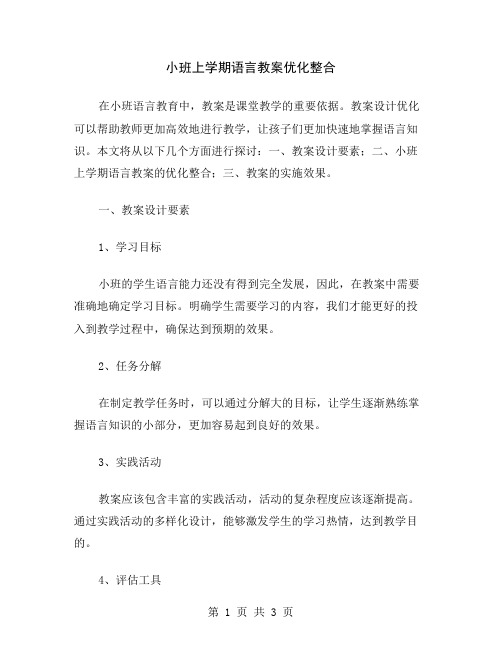
小班上学期语言教案优化整合在小班语言教育中,教案是课堂教学的重要依据。
教案设计优化可以帮助教师更加高效地进行教学,让孩子们更加快速地掌握语言知识。
本文将从以下几个方面进行探讨:一、教案设计要素;二、小班上学期语言教案的优化整合;三、教案的实施效果。
一、教案设计要素1、学习目标小班的学生语言能力还没有得到完全发展,因此,在教案中需要准确地确定学习目标。
明确学生需要学习的内容,我们才能更好的投入到教学过程中,确保达到预期的效果。
2、任务分解在制定教学任务时,可以通过分解大的目标,让学生逐渐熟练掌握语言知识的小部分,更加容易起到良好的效果。
3、实践活动教案应该包含丰富的实践活动,活动的复杂程度应该逐渐提高。
通过实践活动的多样化设计,能够激发学生的学习热情,达到教学目的。
4、评估工具教案中的评估工具必不可少,这有助于教师判断学生的掌握情况,进一步制定针对性的教学目标。
二、小班上学期语言教案的优化整合1、教学内容优化在小班上,需要选择一些孩子易理解的教学语言,因此,教学内容设计中应该减少过于复杂的语言。
教学内容应该抓住孩子的生活经验,通过有趣、实用的教学例子来帮助孩子更好地理解、掌握语言知识。
2、优化教材选择小班教学内容中多采用一些儿歌、童谣、小故事等,这些教材是丰富、生动的,能够增强孩子的学习兴趣。
因此,在选择教材时,应该优先考虑选用这些教材。
3、整合教学资源不同的教师在教学上有不同的特长和经验,可以通过在一定范围内整合教学资源,共同完善小班语言课程教学。
同时,还可以让家长参与到教学过程中,提升教学效果。
三、教案的实施效果通过教学实践,将优化后的教学方案应用于实际教学中,可以看到,小班上学期语言教案的优化整合,取得了显著效果。
教育教学质量得到了有效提高,学生语言能力有了明显的提升。
总结:小班语言教育中,教案优化整合能够帮助教师更好地进行教学。
在小班的教学过程中,教师应该根据教学特点和学生的语言水平,制定合理、可操作的教学方案,如此才能真正提高教育教学效果。
新课标下小学语文单元整体教学策略
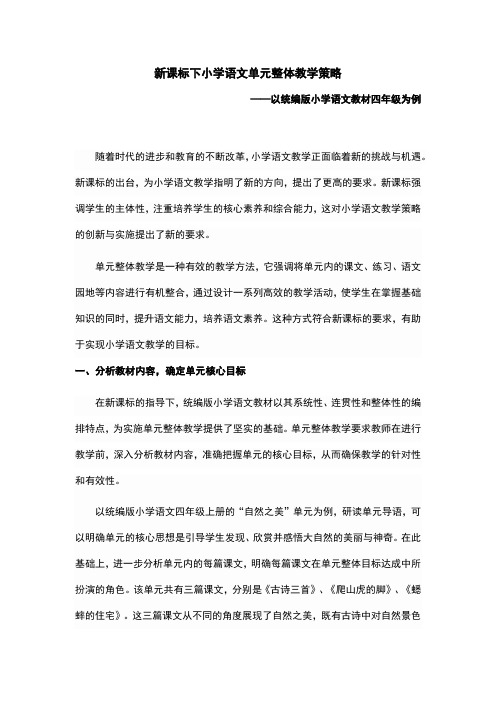
新课标下小学语文单元整体教学策略——以统编版小学语文教材四年级为例随着时代的进步和教育的不断改革,小学语文教学正面临着新的挑战与机遇。
新课标的出台,为小学语文教学指明了新的方向,提出了更高的要求。
新课标强调学生的主体性,注重培养学生的核心素养和综合能力,这对小学语文教学策略的创新与实施提出了新的要求。
单元整体教学是一种有效的教学方法,它强调将单元内的课文、练习、语文园地等内容进行有机整合,通过设计一系列高效的教学活动,使学生在掌握基础知识的同时,提升语文能力,培养语文素养。
这种方式符合新课标的要求,有助于实现小学语文教学的目标。
一、分析教材内容,确定单元核心目标在新课标的指导下,统编版小学语文教材以其系统性、连贯性和整体性的编排特点,为实施单元整体教学提供了坚实的基础。
单元整体教学要求教师在进行教学前,深入分析教材内容,准确把握单元的核心目标,从而确保教学的针对性和有效性。
以统编版小学语文四年级上册的“自然之美”单元为例,研读单元导语,可以明确单元的核心思想是引导学生发现、欣赏并感悟大自然的美丽与神奇。
在此基础上,进一步分析单元内的每篇课文,明确每篇课文在单元整体目标达成中所扮演的角色。
该单元共有三篇课文,分别是《古诗三首》、《爬山虎的脚》、《蟋蟀的住宅》。
这三篇课文从不同的角度展现了自然之美,既有古诗中对自然景色的描绘,也有现代文中对动植物生活习性的生动刻画。
通过研读这些课文,以发现它们之间的内在联系,即都是通过观察和体验自然,引导学生感受大自然的神奇与美丽。
在分析了单元内每篇课文的基础上,再进一步提炼出单元的核心目标。
根据新课标的要求和教材内容的特点,可以将单元核心目标确定为以下三个方面:(1)知识与能力目标。
通过本单元的学习,学生应能够掌握描写自然景物的基本方法,包括如何观察、如何描绘、如何表达等。
同时,学生还应能够积累相关的语言材料,丰富自己的词汇量,提高语言表达能力。
(2)过程与方法目标。
小学英语单元整体教学的思考与实践

小学英语单元整体教学的思考与实践小学英语教学是教育改革的一个重要内容,而小学英语单元整体教学是小学英语教学的重要组成部分。
本文旨在探讨小学英语单元整体教学的思想和实践,旨在改进小学英语教学的质量和效果,为学生提供更高水平的英语学习机会。
一、小学英语单元整体教学思想1.语言教学要重视强化效果。
以语言作为教学整体的中心,要加强教学的强化效果,以便有效地提高学生英语知识的熟练程度。
2.让学生发现教学中的规律。
鼓励学生发现教学法中的规律,让学生掌握语言的基本技能,从而获得真实的语言学习效果。
3.强调运用语言的能力。
小学英语教学中,教师应该培养学生的运用语言的能力,加强对学生运用语言的训练,使学生能够说出有用的英语句子。
二、小学英语单元整体教学的实践1.提出中心话题,引起学生的兴趣。
教师要找到一个学生感兴趣的话题,开展课堂活动,以此引起学生的兴趣,让他们主动参与到课堂活动中来。
2.以小组活动为主,变换教学形式。
小组活动可以更有效地调动学生学习积极性,促进学生的参与度,让学生在积极的氛围中学习英语。
3.教师要根据学生的水平,合理设计教学计划,及时有效评价学生的学习效果。
根据学生的英语水平不同,教师应制定不同学习计划,及时调整教学内容,有效评估学生的学习效果,及时改进教学结构,以达到良好的教学效果。
综上所述,小学英语单元整体教学思想是强调语言教学的强化效果,让学生发现教学中的规律,强调运用语言的能力;而抓住学生发展规律,以小组活动为主,变换教学形式,根据学生的水平,合理设计教学计划,及时有效评价学生的学习效果,是小学英语单元整体教学的实践要求。
只有在此基础上,教师才能真正做到用心教育,让学生得到更新鲜,更有趣,更有效的英语学习机会,从而达到提高学生英语素养的目的。
小学英语单元整体教学设计的策略研究

小学英语单元整体教学设计的策略研究在小学英语单元整体教学设计中,教师可以运用以下策略来提高教学效果:1.渗透性教学策略:在整个学期的教学过程中,教师可以将英语单元的内容融入到日常生活中,使学生能够在不知不觉中学习并运用英语。
比如,在进行购物、外出游玩等活动时,教师可以引导学生使用英语与他人交流,同时进行相关词汇和句型的复习和运用。
2.游戏化教学策略:通过游戏化教学可以提高学生的兴趣和参与度,使他们在轻松愉快的氛围中学习英语。
教师可以设计各种语言游戏、角色扮演活动等,让学生在游戏中运用英语口语和词汇,提高他们的语言能力。
3.多模态教学策略:通过多种媒体和教学资源来进行教学,如图画、视频、音频等,以满足学生多样化的学习需求。
例如,教师可以播放英文儿歌、动画片等视频资源,让学生通过观看并模仿,提高他们的听力和口语表达能力。
同时,配合图画和图片等教学材料,帮助学生学习和记忆单词和句型。
4.学生主导教学策略:在教学过程中,教师可以鼓励学生主动参与课堂活动,提供多种学习方式和机会,培养学生的学习主动性和合作意识。
例如,教师可以让学生分组进行小组讨论,通过合作探究和讨论,提高学生的思维能力和语言表达能力。
5.情景教学策略:将英语单元的学习内容与实际情景结合起来,创设各种活动和场景,帮助学生将学到的知识应用到实际生活中。
例如,针对购物场景,教师可以设置小型商店,让学生扮演购物者和商家,进行针对性的角色扮演和实地体验,以提高学生用英语进行真实交流的能力。
6.全体激励策略:通过激励和奖励机制,激发学生学习英语的积极性和主动性。
教师可以设置学习目标,设立小型竞赛和评比,并给予学生相应的奖励和认可。
此外,教师还可以鼓励学生进行自主学习和自我评价,让学生在学习过程中不断进步和成长。
总之,通过以上策略的综合运用,可以在小学英语单元整体教学设计中提高学生的学习兴趣、参与度和学习效果,促进学生在语言技能、交际能力和思维能力等方面的全面发展。
基于核心素养的小学语文单元整体教学策略

-119-2024年第6期(总第382期)教学案例《义务教育语文课程标准(2022年版)》(下文简称“新课标”)指出了核心素养的导向地位,倡导语文教师将核心素养渗透到语文教学实践中,培养学生的语用意识、思维品质,提升学生的综合素养、实践能力。
单元整体教学区别于传统的单篇文本或单个模块教学模式,是以单元主题为核心,以听、说、读、写多元融合为主要形式的一种综合性教学模式,它注重对教学内容的拆解、重构和组合,重视语文知识之间的内在联系,能够为核心素养的落实提供广阔的平台。
基于此,教师要认清核心素养的导向地位,将其视为语文教学的指导理念,以此进行单元整体教学的设计、实施和总结,同时将核心素养培养贯穿于学生的单元学习活动中。
一、基于核心素养的小学语文单元整体教学的重要意义(一)有助于提高语文教学的质量在传统的语文课堂中,教师基本采用单篇教学法,即在一堂课中仅对一篇文本进行精讲精练。
但是,语文教材中同一单元不同文章的知识点可能是重复的,因此,单篇教学可能会出现教学内容重复、教学方式相似等情况,从而降低语文教学的效率。
而以核心素养为导向的单元整体教学按照特定的顺序,依据一定的逻辑,将教学内容重新组合,可以有效避免内容重复、课堂教学效率低等情况。
当教学效率逐渐提升,语文教学的总体质量也会有所提高[1]。
(二)有助于培养学生的探究能力小学生正处于认知发展的关键时期,此时,他们对未知事物、外界环境有较强的求知欲和探索欲。
单元整体教学比较契合小学生认知发展的基本情况,能够为学生打造自主学习、深层探究的平台,让学生开展不同形式的语文学习活动,如读写实践活动、综合学习活动等。
在参与多样化学习活动的过程中,学生便可发展自主探究能力,并在长期的单元学习中不断强化探究能力。
(三)有助于发展学生的思维品质在基于核心素养的单元整体教学中,教师需要围绕特定的主题、逻辑线索等,将同一大概念下的知识组合为一体,并以系统化、组合化的方式呈现给学生。
幼儿园语言教育的方式与策略
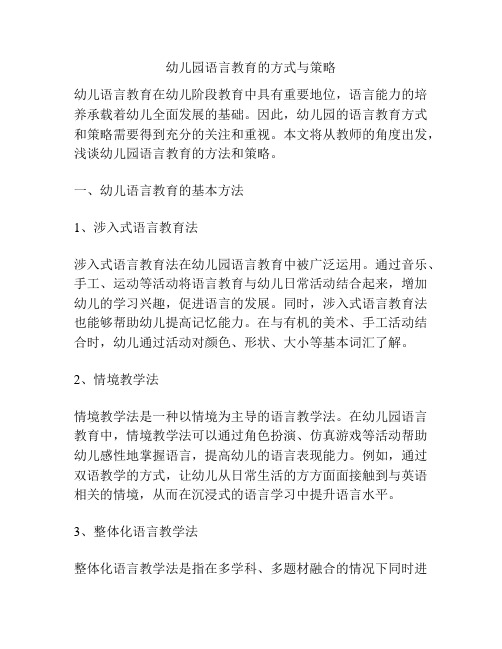
幼儿园语言教育的方式与策略幼儿语言教育在幼儿阶段教育中具有重要地位,语言能力的培养承载着幼儿全面发展的基础。
因此,幼儿园的语言教育方式和策略需要得到充分的关注和重视。
本文将从教师的角度出发,浅谈幼儿园语言教育的方法和策略。
一、幼儿语言教育的基本方法1、涉入式语言教育法涉入式语言教育法在幼儿园语言教育中被广泛运用。
通过音乐、手工、运动等活动将语言教育与幼儿日常活动结合起来,增加幼儿的学习兴趣,促进语言的发展。
同时,涉入式语言教育法也能够帮助幼儿提高记忆能力。
在与有机的美术、手工活动结合时,幼儿通过活动对颜色、形状、大小等基本词汇了解。
2、情境教学法情境教学法是一种以情境为主导的语言教学法。
在幼儿园语言教育中,情境教学法可以通过角色扮演、仿真游戏等活动帮助幼儿感性地掌握语言,提高幼儿的语言表现能力。
例如,通过双语教学的方式,让幼儿从日常生活的方方面面接触到与英语相关的情境,从而在沉浸式的语言学习中提升语言水平。
3、整体化语言教学法整体化语言教学法是指在多学科、多题材融合的情况下同时进行语言教学。
在幼儿园语言教育中,整体化语言教学法可以通过生活游戏、英文童谣、英文绘本等形式让幼儿在多样的情境中容易学习英文,这也是幼儿掌握英文不局限于学习课本的重要途径之一。
二、幼儿语言教育的策略1、创建语言的沉浸式环境在幼儿园,创造语言的沉浸式环境是幼儿语言教育成功的关键。
在这个环境中,幼儿可以在日常活动中轻松自如地沟通,同时也能够听到和看到英文,这种语言环境的构建有效提升了幼儿英语的使用习惯。
2、运用多元化的教学资源运用多元化的教学资源是幼儿语言教育的又一个重要策略。
丰富多彩的活动方式,例如唱歌、玩具配对、手工创意等各种模式使用都起重要作用,不仅拓宽了幼儿的视野也增强了学习的有效性并让英文学习的过程变得更有趣。
3、尽可能贴近生活实际幼儿园英语教师需要尽可能贴近生活实际,让日常生活各方面都与英语相关联。
例如,让幼儿学会用英语表达姓名、日常食物、穿衣要求等基础生活词汇等,在学习过程当中幼儿既能体会英语之美也能同时深入认识家庭,寓教于乐、内化于心让幼儿轻松掌握英语。
小学语文单元整体教学存在的问题及策略分析

小学语文单元整体教学存在的问题及策略分析随着教育的发展和改革,语文教学已经成为学校教育的重要组成部分。
小学语文教学作为学生语言表达与传播能力、阅读能力和写作能力的重要培养阶段,所以语文整体教学的优劣将直接影响到学生未来的发展。
当前小学语文单元整体教学中依然存在着不少问题,例如教学内容单一、学生学习兴趣不高等。
本文将针对这些问题进行分析,并提出相应的教学策略。
问题一:教学内容单一在小学语文教学中,通常会以课文为主、辅助以一些文字材料和习题,教学内容比较单一。
这样的教学方法容易导致学生的学习兴趣不高,且只是停留在课文的表面理解,难以形成对语文内容的整体把握。
策略分析:应该在教学中加入更多的丰富多彩的学习内容,比如文学作品、古诗词、历史典故等。
可以结合学生的兴趣点,引导他们进行自主阅读和欣赏。
这样可以提高学生对语文的兴趣,帮助他们建立更加深入的理解和认识。
问题二:思维能力不足在小学语文教学中,通常是老师传授知识,学生被动接受,缺少锻炼学生的独立思考和创造能力。
导致学生的认知水平较低,对于学习中的难点问题缺乏解决能力。
策略分析:应该引导学生进行独立思考和自主探究,给予学生一定的自由度,让他们多思考、多探索。
可以采用小组讨论、问题解答、综合应用等方式,来培养学生的综合分析和解决问题的能力,提高学生的综合素质。
问题三:缺乏与现实生活联系目前的小学语文教学中,内容大多是纯粹的文学作品,与学生日常生活缺乏联系,使学生难以认识和理解学习内容的实际意义和价值。
策略分析:在教学中应该结合学生的生活实际,引导学生通过阅读理解文学作品和其他文字材料,从中感受并体验到情感、情境、情境中的诗情画意。
通过与学生生活的结合,使学生更加易于接受和理解教学内容,激发学生学习的兴趣。
问题四:缺乏国学教育在当前的小学语文教学中,大多数的教学内容更加侧重现代文学,而缺乏对国学经典的传承和教育。
导致学生缺乏对传统文化的了解和传承,对于国学经典的理解程度较低。
培育语文核心素养:教学策略与方法路径探讨
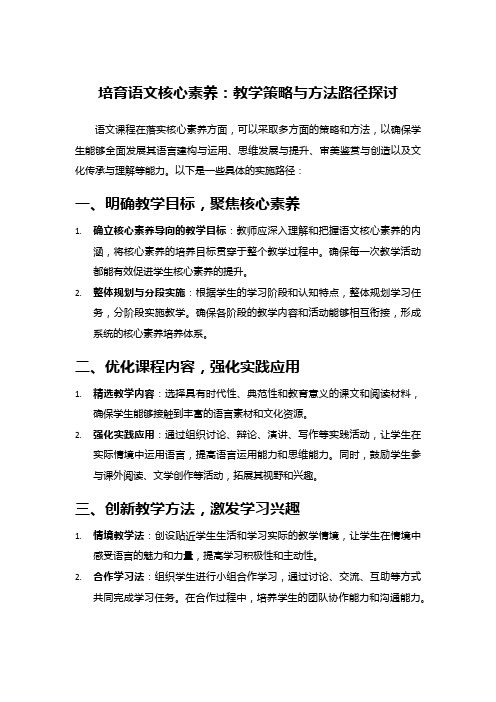
培育语文核心素养:教学策略与方法路径探讨语文课程在落实核心素养方面,可以采取多方面的策略和方法,以确保学生能够全面发展其语言建构与运用、思维发展与提升、审美鉴赏与创造以及文化传承与理解等能力。
以下是一些具体的实施路径:一、明确教学目标,聚焦核心素养1.确立核心素养导向的教学目标:教师应深入理解和把握语文核心素养的内涵,将核心素养的培养目标贯穿于整个教学过程中。
确保每一次教学活动都能有效促进学生核心素养的提升。
2.整体规划与分段实施:根据学生的学习阶段和认知特点,整体规划学习任务,分阶段实施教学。
确保各阶段的教学内容和活动能够相互衔接,形成系统的核心素养培养体系。
二、优化课程内容,强化实践应用1.精选教学内容:选择具有时代性、典范性和教育意义的课文和阅读材料,确保学生能够接触到丰富的语言素材和文化资源。
2.强化实践应用:通过组织讨论、辩论、演讲、写作等实践活动,让学生在实际情境中运用语言,提高语言运用能力和思维能力。
同时,鼓励学生参与课外阅读、文学创作等活动,拓展其视野和兴趣。
三、创新教学方法,激发学习兴趣1.情境教学法:创设贴近学生生活和学习实际的教学情境,让学生在情境中感受语言的魅力和力量,提高学习积极性和主动性。
2.合作学习法:组织学生进行小组合作学习,通过讨论、交流、互助等方式共同完成学习任务。
在合作过程中,培养学生的团队协作能力和沟通能力。
3.信息技术辅助教学:充分利用多媒体、网络等信息技术手段辅助教学,丰富教学资源和教学手段。
通过制作课件、播放视频、开展在线互动等方式激发学生的学习兴趣和创造力。
四、注重评价反馈,促进持续发展1.多元化评价:采用多种评价方式和方法对学生的学习情况进行全面评估。
包括课堂表现评价、作业评价、测试评价、自我评价和同伴评价等。
确保评价结果的客观性和准确性。
2.过程性评价:关注学生的学习过程和发展变化,及时给予反馈和指导。
通过定期的学习反思和总结活动帮助学生发现自身存在的问题和不足并制定改进措施。
双新课标背景下:小学英语单元整体教学的具体策略与方法

双新课标背景下:小学英语单元整体教学的具体策略与方法教师在备教材时需要分析教材的什么?对此,教育学和教学论著作却没有深究这个问题。
由于道理上没有说清楚或未经教师掌握,教师在分析教材时就难免出现各种各样的偏差。
通过阅读大量的教师教学设计方案、教师集体备课,笔者发现,教师的教材分析主要是对教科书中的知识点及其重点和难点的分析。
这种分析存在以下问题:局限于教材的教学内容分析,没有分析教材中的教学目标、教学内容的呈现方式等其他教材要素,不能完整地理解教材;对教材的分析停留在阅读、浏览的表层水平,没有深入到教材里面,了解教材编写的意图和所依据的原理。
由于对教材分析的片面性和肤浅性,教师在实际的课堂教学过程中就会出现孤立地肤浅地呈现知识点、脱离教材以及随意呈现教学内容的问题。
从单元整体视角该怎样进行教材的分析与设计呢?结合北京市东城区府学小学赵立英老师的教学实践研究案例,梳理思路如下:1. 首先要进行学情分析。
学情分析包括学生原有知识基础,学生的生活经验,学生的认知特点,以及学生是否熟悉的学习方式等。
2.其次,以话题为核心全面梳理。
从单元整体教学视角进行教材分析,在分析学生基本情况的基础上,首先要明确提炼出话题或主题,准确把握语境,明确语言功能;其次是对重点语言,包括结构、词汇等的梳理,还要分析涉及到的相关文化,以及内容本身所折射或渗透的价值观。
教师整体把握教学内容和教学过程,在组织单元教学时,只要以话题为中心、以学生为主体、以任务为前提,围绕话题并根据学生的认知能力由浅入深地拓展教学内容,就可以把一些本来零散的教学内容整体化,相关话题的内容系统化,使整个教学过程相互联系、环环相扣。
只要教师在课堂教学中恰当、合理地做好任务转换,就可以让学生对教学的各个环节充满好奇与期待,学生在整个单元教学中都会处在热切的关注和参与中。
无论单元还是课时,从单元整体视角进行教材分析首先要关注课程内容的整体性。
在此,教师要区分好课程内容、教材内容、教学内容三个概念。
单元整体教学在小学英语课堂中的有效设计和思考
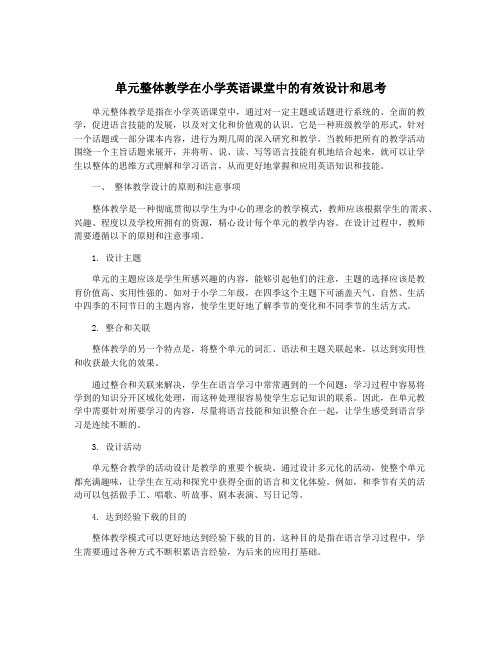
单元整体教学在小学英语课堂中的有效设计和思考单元整体教学是指在小学英语课堂中,通过对一定主题或话题进行系统的、全面的教学,促进语言技能的发展,以及对文化和价值观的认识。
它是一种班级教学的形式,针对一个话题或一部分课本内容,进行为期几周的深入研究和教学。
当教师把所有的教学活动围绕一个主旨话题来展开,并将听、说、读、写等语言技能有机地结合起来,就可以让学生以整体的思维方式理解和学习语言,从而更好地掌握和应用英语知识和技能。
一、整体教学设计的原则和注意事项整体教学是一种彻底贯彻以学生为中心的理念的教学模式,教师应该根据学生的需求、兴趣、程度以及学校所拥有的资源,精心设计每个单元的教学内容。
在设计过程中,教师需要遵循以下的原则和注意事项。
1. 设计主题单元的主题应该是学生所感兴趣的内容,能够引起他们的注意,主题的选择应该是教育价值高、实用性强的。
如对于小学二年级,在四季这个主题下可涵盖天气、自然、生活中四季的不同节日的主题内容,使学生更好地了解季节的变化和不同季节的生活方式。
2. 整合和关联整体教学的另一个特点是,将整个单元的词汇、语法和主题关联起来,以达到实用性和收获最大化的效果。
通过整合和关联来解决,学生在语言学习中常常遇到的一个问题:学习过程中容易将学到的知识分开区域化处理,而这种处理很容易使学生忘记知识的联系。
因此,在单元教学中需要针对所要学习的内容,尽量将语言技能和知识整合在一起,让学生感受到语言学习是连续不断的。
3. 设计活动单元整合教学的活动设计是教学的重要个板块。
通过设计多元化的活动,使整个单元都充满趣味,让学生在互动和探究中获得全面的语言和文化体验。
例如,和季节有关的活动可以包括做手工、唱歌、听故事、剧本表演、写日记等。
4. 达到经验下载的目的整体教学模式可以更好地达到经验下载的目的。
这种目的是指在语言学习过程中,学生需要通过各种方式不断积累语言经验,为后来的应用打基础。
在小学英语教学中,一些活动,比如听英语短剧、唱英语歌曲等,会让学生在不知不觉中扩大了他们的语言库。
小学语文单元整体教学存在的问题及策略分析
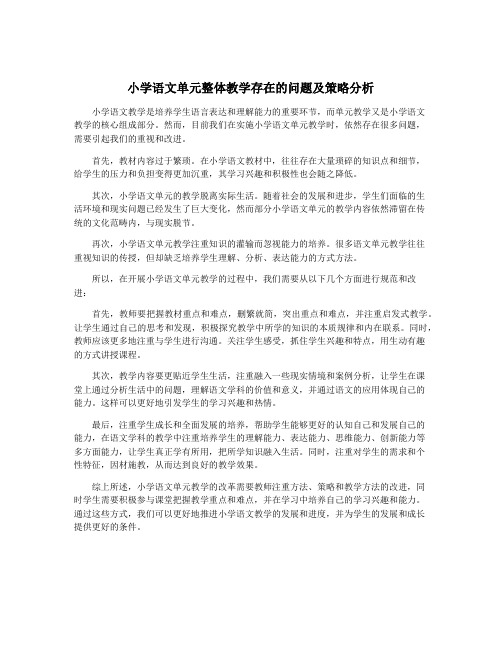
小学语文单元整体教学存在的问题及策略分析小学语文教学是培养学生语言表达和理解能力的重要环节,而单元教学又是小学语文教学的核心组成部分。
然而,目前我们在实施小学语文单元教学时,依然存在很多问题,需要引起我们的重视和改进。
首先,教材内容过于繁琐。
在小学语文教材中,往往存在大量琐碎的知识点和细节,给学生的压力和负担变得更加沉重,其学习兴趣和积极性也会随之降低。
其次,小学语文单元的教学脱离实际生活。
随着社会的发展和进步,学生们面临的生活环境和现实问题已经发生了巨大变化,然而部分小学语文单元的教学内容依然滞留在传统的文化范畴内,与现实脱节。
再次,小学语文单元教学注重知识的灌输而忽视能力的培养。
很多语文单元教学往往重视知识的传授,但却缺乏培养学生理解、分析、表达能力的方式方法。
所以,在开展小学语文单元教学的过程中,我们需要从以下几个方面进行规范和改进:首先,教师要把握教材重点和难点,删繁就简,突出重点和难点,并注重启发式教学。
让学生通过自己的思考和发现,积极探究教学中所学的知识的本质规律和内在联系。
同时,教师应该更多地注重与学生进行沟通。
关注学生感受,抓住学生兴趣和特点,用生动有趣的方式讲授课程。
其次,教学内容要更贴近学生生活,注重融入一些现实情境和案例分析,让学生在课堂上通过分析生活中的问题,理解语文学科的价值和意义,并通过语文的应用体现自己的能力。
这样可以更好地引发学生的学习兴趣和热情。
最后,注重学生成长和全面发展的培养,帮助学生能够更好的认知自己和发展自己的能力,在语文学科的教学中注重培养学生的理解能力、表达能力、思维能力、创新能力等多方面能力,让学生真正学有所用,把所学知识融入生活。
同时,注重对学生的需求和个性特征,因材施教,从而达到良好的教学效果。
综上所述,小学语文单元教学的改革需要教师注重方法、策略和教学方法的改进,同时学生需要积极参与课堂把握教学重点和难点,并在学习中培养自己的学习兴趣和能力。
小班教学中的语言学习策略

小班教学中的语言学习策略在小班教学中,语言学习策略是促进幼儿语言发展的重要手段。
通过运用合适的语言学习策略,教师可以帮助幼儿扩大词汇量,提高语言表达能力,并促进他们在语言交流中的自信和积极性。
本文将介绍小班教学中的一些有效的语言学习策略,并探讨其实施方法和效果。
一、以游戏为主导的学习策略在小班教学中,游戏是幼儿学习语言的最佳活动之一。
教师可以设计各种有趣的语言游戏,通过游戏帮助幼儿积极参与、主动表达。
例如,可以组织幼儿进行角色扮演,让他们在扮演不同角色的过程中学习和运用新的词汇和句型。
同时,教师还可以设计一些配套的语言游戏,如拼图游戏、看图说话等,引导幼儿运用学到的知识进行交流。
二、启发式教学策略启发式教学策略是指通过启发幼儿的思维,引导他们主动参与和发现语言规律。
教师可以提出一些引导性的问题,激发幼儿思考和探索。
例如,在进行词汇教学时,教师可以给出一张图片,然后提问:“你能说出这个图片中的物品是什么吗?”通过这样的启发性提问,幼儿可以通过观察和思考,自己尝试使用新的词汇进行表达。
三、情境教学策略在小班教学中,情境教学策略可以提供一个真实的语言环境,让幼儿在实际情境中学习和运用语言。
例如,教师可以模拟日常生活中的场景,如购物、做饭等,在这些情境中引导幼儿进行语言交流。
同时,教师还可以邀请家长和其他幼儿一起参与,扩大幼儿的语言交际圈,让他们在交流中不断学习和提高。
四、多媒体教学策略多媒体教学策略利用现代科技手段,将图像、音频、视频等多种媒体形式结合起来,提供丰富的语言学习资源。
教师可以通过使用幼儿喜欢的动画片、儿歌、故事书等,吸引幼儿的注意力,激发他们学习语言的兴趣。
同时,教师还可以利用多媒体教学手段进行互动教学,鼓励幼儿参与到语言学习中,提高学习效果。
五、评估和反馈策略评估和反馈策略在语言学习中起到至关重要的作用。
教师可以通过观察幼儿的表现、记录其语言发展情况来评估幼儿的学习进度。
同时,教师还可以定期与幼儿进行交流,给予积极的反馈和鼓励。
论文高中英语大单元整体教学的策略及意义

浅谈高中英语大单元教学的策略及意义摘要高中英语大单元整体教学是指将语言技能和语言知识同步教授,涵盖听、说、读、写、翻译和文化素养等多个方面,从而帮助学生全面提高英语水平。
本论文通过对相关文献的研究,探讨了高中英语大单元整体教学的策略和意义。
首先,分析了高中英语大单元整体教学的理论基础和研究现状,然后结合实践经验,总结了教师应该采取的策略,包括:制定完整的教学计划,注重任务型教学,多元化评估方法,建立学生自主学习机制等。
最后,探讨了高中英语大单元整体教学的意义,认为该教学模式有助于提高学生的语言综合能力和文化素养,有利于英语教学的实践与创新。
关键词:高中英语;大单元;整体教学;策略;意义AbstractThe holistic teaching of high school English units refers to the synchronous teaching of language skills and language knowledge, covering multiple aspects such as listening, speaking, reading, writing, translation and cultural literacy, to help students improve their English skills comprehensively. This thesis explores the strategies and significance of the holistic teaching of high school English units throughthe study of relevant literature. First, it analyzes the theoretical basis and research status of the holistic teaching of high school English units, and then combines practical experience to summarize the strategies that teachers should adopt, including: developing a complete teaching plan, paying attention to task-based teaching, diversified assessment methods, and establishing student autonomous learning mechanisms. Finally, the significance of the holistic teaching of high school English units is discussed, and it is believed that this teaching model can help improve students’language comprehensive ability and cultural literacy, and is conducive to the practice and innovation of English teaching.Keywords: high school English;units;holistic teaching;strategies;significancePart 1. IntroductionAs the world’s most widely used language, English plays an increasingly important role in international communication, trade, and cultural exchange. China's accession to the World Trade Organization, the rapid development of global economic integration, and the trend of knowledge-based economic development have all promoted the teaching of English in China to a higher level, with more emphasis on developing students’language skills and cultural literacy.English teaching in high schools is the key stage of language education in China. In recent years, with the continuous reform of the education system, the teaching model of high school English has also undergone significant changes. The traditional teaching model that focuses on teaching knowledge has been gradually transformed into a practical teaching model that emphasizes the cultivation of students’language skills and cultural literacy.One of the innovative teaching models that have emerged in recent years is the holistic teaching of high school English units. Compared with the traditional teaching model, the holistic teaching model emphasizes the importance of integrating language skills and knowledge, and pays attention to developing students’language comprehensive ability and cross-cultural communication skills. Therefore, the holistic teaching of high school English units has attracted widespread attention from teachers and researchers.This article aims to explore the strategies and significance of the holistic teaching of high school English units. First, the theoretical basis and research status of the holistic teaching model are analyzed. Then, based on practical experience, several effective teaching strategies aresummarized. Finally, the significance of the holistic teaching of high school English units is discussed, and the value of this teaching model for English teaching innovation and practice will be highlighted.Part 2. The theory of integrated instructionIntegrated instruction refers to a teaching model that combines multiple subjects or disciplines into a single course (Corcoran, Mosher, & Rogat, 2009). The purpose of integrated instruction is to promote students’understanding of the interrelatedness of different fields of knowledge, as well as their problem-solving and critical thinking skills.Integrated instruction is based on the notion that knowledge is not fragmented, and it is not necessary to separate knowledge into different disciplines. Instead, knowledge should be integrated and interconnected, and teaching should reflect the complexities of the real-world (Wiggins & McTighe, 2011).The holistic teaching of high school English units adopts an integrated approach to language teaching. In other words, it combines different aspects of English teaching, including listening, speaking, reading, writing, translation, and culture, into a single unit, which reflects theinterrelatedness of different aspects of language learning.The research on the holistic teaching of high school English units is still in its early stages. Most of the existing studies have focused on the effectiveness of the teaching model, the feasibility of implementation, and the comparison with traditional teaching models.Chiang (2015) conducted a study to investigate the effects of the holistic teaching model on students’reading ability and motivation. The results showed that students who received holistic teaching had significantly higher reading ability scores and more positive attitudes towards reading than those who received traditional teaching.Kao and O’Brien (2015) conducted a study to explore teachers’perceptions of the holistic teaching model. The study found that teachers believed the holistic teaching model could promote students’language skills, cultural understanding and critical thinking skills. However, teachers also noted that implementing the holistic teaching model requires considerable effort in curriculum development and the design of instructional materials.In summary, the theoretical basis of the holistic teaching of high schoolEnglish units is grounded in the theories of task-based language teaching and integrated instruction. Although the research on this teaching model is limited, there is evidence to suggest that it has the potential to improve students’language skills and cultural literacy.Part 3. Teaching Strategies3.1 Develop a complete teaching planDeveloping a complete teaching plan is essential for implementing the holistic teaching of high school English units. The plan should include the objectives, the content, the teaching methods, the evaluation methods, and the resources needed for each unit. The plan should also reflect the integration of different aspects of language teaching, such as listening, speaking, reading, and writing. A well-designed teaching plan can provide a clear direction for both teachers and students, and ensure the efficient implementation of the teaching model.3.2 Task-based teachingTask-based teaching is a core concept of the holistic teaching of high school English units. Tasks can be designed to involve students inauthentic and meaningful language use, which is the key to the development of communicative competence. Additionally, the tasks should involve students in the integration of different aspects of language learning, providing opportunities for students to develop their language skills comprehensively.For example, the task of writing a travel diary can integrate writing, reading, and speaking skills, as well as cultural knowledge. In addition, the task of conducting an interview presents an opportunity for students to practice their listening and speaking skills, as well as their research skills. Task-based teaching not only helps to promote students’language skills but also stimulates their interest in language learning.3.3 Diversified assessment methodsThe holistic teaching model emphasizes the importance of comprehensive evaluation. Therefore, teachers should adopt diversified assessment methods to evaluate students’language skills and cultural understanding. Assessment methods may include oral presentations, written tests, group projects, and portfolio assessments. The diversified assessment methods can not only provide a comprehensive and accurate evaluation of students’performance but also motivate students toengage in active learning.3.4 Establish student autonomous learning mechanismsTo implement the holistic teaching of high school English units successfully, it is essential to establish student autonomous learning mechanisms. This means that students should be encouraged and enabled to take responsibility for their own learning process. Teachers can provide students with learning resources such as authentic materials, online resources, and peer feedback. Teachers should also guide students to develop self-evaluation skills, which can help them monitor and improve their language learning progress.Part 4. Significance4.1 Engage students in language useOne of the significant benefits of the holistic teaching of high school English units is that it engages students in language use, rather than teaching language knowledge only. Students are encouraged to use the language in meaningful and authentic contexts, which can help them develop their communicative competence. Communicative competence is the ability to use language functionally and pragmatically insocio-cultural contexts. Authentically task-oriented teaching provides students with opportunities to encounter and negotiate meaning, leading to language use leading to more successful communicative competence.4.2 Promote students’language comprehensive abilityThe holistic teaching model integrates different aspects of language learning, including listening, speaking, reading, writing, translation, and culture, into a single unit. Therefore, it provides opportunities for students to practice their language skills comprehensively, leading to a more complete mastery of the language. The aim of the holistic teaching of high school English units is to develop students’language comprehensive ability, which includes linguistic competence, strategic competence, socio-linguistic competence, discourse competence, and cultural competence (Canale & Swain, 1980).4.3 Develop students’cultural literacyThe holistic teaching of high school English units aims to integrate cultural elements into language teaching. Therefore, it provides opportunities for students to enhance their cultural literacy, which refers to the ability to understand and appreciate different culturalperspectives. By exposing students to a range of cultural materials, students are better able to understand and appreciate the different cultural perspectives in the world. Additionally, it provides the opportunity for students to integrate cultural elements into their language use, improving their communicative competence.4.4 Encourage innovation in English teachingThe holistic teaching model encourages innovation in English teaching. By integrating different aspects of language learning, task-based teaching, and diversified assessment methods, as well as enhancing cultural literacy, it promotes English teaching practice that is grounded in contemporary theories and practices. The holistic teaching of high school English units provides opportunities for teachers to design creative materials and develop effective teaching strategies, leading to innovative teaching approaches in English classes.Part 5. ConclusionThe holistic teaching of high school English units is a new and innovative teaching model that emphasizes the integration of multiple aspects of language learning. This model is grounded in the theories of task-based language teaching and integrated instruction, and aims to promotestudents’language comprehensive ability and cultural literacy. To implement the model successfully, teachers should adopt effective teaching strategies such as developing a complete teaching plan, task-based teaching, diversified assessment methods, and establishing student autonomous learning mechanisms. It is hoped that the holistic teaching of high school English units will encourage innovation and best practices in English teaching and become a new model in English education.。
小学语文单元整体教学存在的问题及策略分析

小学语文单元整体教学存在的问题及策略分析语文教学是小学教育的重要组成部分,是培养学生语言表达能力、阅读能力和写作能力的关键环节。
随着教育的不断发展,小学语文教学也面临着许多问题,如单元整体教学存在的问题。
本文将就小学语文单元整体教学存在的问题及相应的策略进行分析,以期为语文教师提供一些思路和方法。
1. 教师侧重点不清:在语文单元整体教学中,一些教师往往侧重于讲授知识点,而忽视了知识点之间的联系和整体的把握。
这就导致了学生容易出现“知识点零散,整体把握不清”的情况。
2. 学生学习兴趣不高:目前一些学生缺乏对语文学习的兴趣,单元整体教学缺乏趣味性,学生难以全面领悟和掌握知识点。
3. 学生学习压力大:小学生学习任务繁重,语文单元整体教学存在着信息过载的问题,让学生感到学习的压力过大。
4. 教学资源不足:一些学校的教学资源较为匮乏,导致了语文单元整体教学教学手段单一、教材选择有限的问题。
二、解决问题的策略分析1. 建立整体教学理念:教师应该树立整体教学观念,不仅注重知识点的讲解,更要注重知识之间的联系,帮助学生建立起整体的识别与把握能力。
教师要抓住每个知识点的内在联系,通过知识融贯,有机的整合知识点,使得学生能够从整体中领悟知识点,这样才能够使得学生更好的掌握整体知识。
2. 创设趣味性教学环境:在单元整体教学中,教师要注重培养学生对语文学习的兴趣,可以通过多媒体教学、课外阅读、游戏互动等方式,让学生在轻松愉快的氛围中学习,激发学生的学习兴趣。
3. 缓解学生学习压力:教育部门和学校要合理控制小学生学习任务,减轻学生学习压力。
教师在语文单元整体教学中应该因材施教,从学生的实际情况出发,设置合理的学习目标,让学生学会自主学习,不要把学生死记硬背,要注重培养他们解决问题的能力。
4. 优化教学资源:学校和教育部门应该加大对教学资源的投入,提供更多的教学设备和教学材料。
教师在语文单元整体教学中要灵活运用各种教学资源,使得教学更加多元化、丰富化。
主题意义引领下,整体模块教学助力学生语言输出的有效策略

教改课改主题意义引领下,整体模块教学助力学生语言输出的有效策略何碧筠J_AOGA_ KEGA-(广东省广州市花都区新华街第五小学,广东广州510800)摘要:学生学习英语最终的目的是运用语言表达自己所想,与人沟通交流。
文章把握住提高学生语言运用能力的关键点,对教材的编排特点进行分析,从整体模块教学的角度出发,通过实施有效的策略,让学生知道模块主题谈及的内容和意义,掌握与本主题相关的单词、句型,有一定的语言积累,内化所学语言,最后懂得围绕主题运用语言,有效输出语言。
教师通过主题意义引领,深挖文本中与价值取向相关的内容,影响学生的行为,帮助学生树立正确的世界观、人生观和价值观,充分地体现了英语学科的育人功能。
关键词:小学英语;整体模块教学;语言运用;核心素养中图分类号:G623.31文献标识码:A 文章编号:2095-624X(2021)15-0033-02英语作为语言,是国际交往的重要工具,学习英语最终的目的是运用语言表达自己所想和别人交流,因此,在英语教学过程中,各教学环节都应以提高学生的综合语言运用能力为核心去开展,最终让学生达到运用语言的目的。
在《义务教育英语课程标准(2011年版)》中,课程目标结构图可看出课程目标中语言技能、语言知识、情感态度、学习策略和文化意识五个方面都指向综合语言运用能力。
广州地区所用教育科学出版社的英语教材的编排特点是以模块为主题,每一个模块包括两个Unit,两个Unit的内容都是围绕模块主题并涉及模块主题的多个方面,为学生提供更多的语言素材,学生学完整个模块后,能运用所学单词、句型围绕主题去表达和与人交流,充分体现了模块主题具有话题的功能性。
学生要想围绕主题运用语言,就要知道本主题谈及的内容和意义,掌握与本主题相关的单词、句型,有一定的语言积累,内化所学语言。
一、围绕魁站耀义我们现用的教材每一个模块都有不同的主题,模块中每一个文本都具有不同的情境和不同的意义,这些意义是通过文本中的词、句去体现的,但很多时候,教师在教学过程中忽略了这一点,把文本的教学变成单纯的词、句教学,导致学生能听、说、读、写单词和句型,但不懂得如何恰当地运用。
初中英语单元整体教学策略研究

初中英语单元整体教学策略研究一、引言英语是一门需要先导性知识和持续性练习的学科,对于中文母语的初中生来说,学习英语是一项全新的挑战。
因此,了解和运用适合初中生的整体教学策略是非常重要的。
本文将研究初中英语单元整体教学策略,探讨如何有效地组织课堂教学,培养学生的英语听、说、读、写能力。
二、概述初中英语教学主要包括词汇、语法、听力、口语、阅读和写作等方面的内容。
针对不同的教学目标,采取不同的教学策略,能够提高学生的学习效果。
三、词汇教学策略1.综合应用:将单词融入到短语、句子和语篇中,让学生在真实语境中学习和掌握。
2.多媒体辅助:利用图片、音频和视频等多媒体资源来呈现单词的意义和用法,提高学生的理解和记忆。
3.重复学习:通过反复练习和巩固来加深对单词的记忆,如使用词卡、单词表和语境填空等活动。
四、语法教学策略1.渐进式教学:从简单到复杂、由浅入深地教授语法知识,注重语法的系统性和层次性。
2.语法归纳:通过观察和探索语言现象,引导学生归纳总结规律,提高语法意识和分析能力。
3.语法应用:将语法知识应用到实际语境中,例如通过口语对话、阅读理解和写作练习来巩固和运用。
五、听力教学策略1.预设任务:在听力材料播放前,给学生明确具体的任务和要点,引导他们主动去关注和理解听力内容。
2.分级训练:根据学生的语言水平和听力能力,选择相应难度的听力材料进行训练,逐步提高学生的听力技能。
3.多种形式的听力练习:除了听材料回答问题,还可以进行听力填表、听力选择等形式的练习,培养学生的听力理解和综合应用能力。
六、口语教学策略1.情景交际:设计真实的情景对话,让学生在仿真场景中进行实际口语表达,提高他们的口语流利度和应对能力。
2.讨论和辩论:引导学生进行讨论和辩论,培养他们的思辨能力和口语表达能力,同时激发他们的兴趣和参与度。
3.角色扮演:通过角色扮演的形式,让学生扮演不同的角色,进行真实对话,充分应用语言知识和技能。
七、阅读教学策略1.预测和预测检测:提供文章的标题、照片和前几句话等信息,引导学生对文章进行预测,然后通过检测来验证预测的准确性。
- 1、下载文档前请自行甄别文档内容的完整性,平台不提供额外的编辑、内容补充、找答案等附加服务。
- 2、"仅部分预览"的文档,不可在线预览部分如存在完整性等问题,可反馈申请退款(可完整预览的文档不适用该条件!)。
- 3、如文档侵犯您的权益,请联系客服反馈,我们会尽快为您处理(人工客服工作时间:9:00-18:30)。
词汇是音、形、义、用法的统一体。
整体语言教学对小学英语教学的启示 (一)词句整体教学
2. 词句整体教学实施策略 掌握语音是学好词汇的前提。
首先要注意词汇教学音和形的统一与结合,教会 学生常见的字母或字母组合的读音规则,帮助学 生掌握正确的拼读形式;
run sun
fun
hungry
bun
整体语言教学对小学英语教学的启示 (一)词句整体教学
整体语言教学对小学英语教学的启示
(二)阅读整体教学
3.阅读整体教学实施策略 整体感知,全面理解阅读材料。
整体呈现阅读材料。 形式一:视听整体呈现。结合文字、图画和声音的输 入方式,从视觉和听觉两方面给学生输入信息,帮助学生快 速把握主旨大意。 形式二:图文整体呈现。学生默读,仅借助图片快速 把握阅读材料大意。
whole不是指全部,而是指“不可分割”(holistic)。
整体语言教学的基本理念
1. whole language--语言是一个整体。
2. whole learner--语言教学应以学生为中心。 3. whole environment--语言知识和技能应 通过自然的语言环境加以培养。
整体语言教学的含义
3.阅读整体教学实施策略
【教学案例再设计】The lion and the mouse.
Step1. Listen, look and judge.(看图片,听短文,并判断) ( )a. There is a lion and a mouse in the story. ( )b. At last(最后), the lion and the small animals are good friends. Step2. Read again and circle the new words. (再读短文,找新词) Step3. Read and fill in the blank. (读短文并填空) a. Lion is coming, mouse is ________. b. Lion is ______ the net. c. Mouse is ______ the net. d. ______ helps lion. Step4. Read after the teacher and choose the right answers.(跟老师边读边选择) Animals strong/small hungry/afraid afraid/brave happy/sad lion mouse Step5. Act the story(借助短文内容拓展,表演故事) Step6. Discuss: Which animal do you like in the story? Why? (你喜欢故事中的哪个动物呢? 能简单说说为什么吗?)
2. 词句整体教学实施策略
词句结合,词不离句
【教学案例2】
单元话题:Location (方位);词汇:in the middle;功能句型:…is in the middle。 T: xx, please come here, go straight and turn right. You, go straight and turn left. xx, go straight and stand in the middle .(教师 引导第3个学生站在中间。) T: Look at them, who’s in the middle? (教师启发性地指着中间的学生) S: xx. T: Yes, you are so clever. Now, who is in the middle?(学生更换位置) S: xx. T: 板书in the middle,并教读。 T: Look, who is in the middle?(老师站在2位学生身边) Ss : xx is in the middle. T: Now, please look at this map. What place is in the middle? S: … is in the middle.
整体语言教学的含义
Whole Language is a set of beliefs about how language learning happens and a set of principles to guide classroom practice.(Goodman, 1967) 整体语言教学是一种关于学习的本性以及如 何在课堂教学中实现真正意义的学习的语言 教育理论和信念系统。
整体语言教学对小学英语教学的启示
(二)阅读整体教学
3.阅读整体教学实施策略 图文整体呈现: The lion and the mouse
Read and answer: What animals are there in the story?
1
2
There is a lion. He is big. He is very strong.
2. 词句整体教学实施策略 掌握语音是学好词汇的前提。
首先要注意词汇教学音和形的统一与结合。
教会学生常见的字母或字母组合的读音规则, 帮助学生掌握正确的拼读形式; 注意及时板书。
整体语言教学对小学英语教学的启示ቤተ መጻሕፍቲ ባይዱ(一)词句整体教学
2. 词句整体教学实施策略 首先要注意词汇教学音和形的统一与结合,注意 单词的板书,注重学生的单词认读能力培养和音 节意识的渗透; 其次要词句结合,做到词不离句,句不离篇。强 调“整句输出”。
简而言之,整体语言教学是指 “完整的学习者” 在 “完整的情境”中 学习“完整的语言”。
整体语言教学对小学英语教学的启示 (一)词句整体教学
1. 整体语言词句观 整体语言教学强调语言的整体性,把语言的三要 素(语音、词汇和语法)看作一个整体,任何企 图把语言肢解成语音、词汇、语法等都会使语言 失去其完整性和真实性。
整体语言教学的基本理念
1. whole language --语言是一个整体。
语言的三要素(语音、词汇和语法)是一个整体,任何企图把 语言肢解成语音、词汇、语法等都会使语言失去其完整性和真 实性; 听、说、读、写是一个整体,不主张肢解语言技能,把听说读 写分开来教;
学与用是一个整体,外语学习的目的是用其所学的语言去表情 达意,执行社会功能。
整体语言教学对小学英语教学的启示
(二)阅读整体教学
3.阅读整体教学实施策略 整体感知,全面理解阅读材料。
整体呈现阅读材料。
围绕主题设计任务。
3.阅读整体教学实施策略
【教学案例】The lion and the mouse.
Step1. Listen and answer. (听短文,并回答问题) Who are in the story? Step2. Read and find. (读短文,找答案) What does the lion or the mouse look like? Step3 Read again and find the new words. (读课文,找新词) afraid, help, biting, net Step4.Read and fill in the blanks (读短文并填空)) 1. The ____is coming, he is_______. 2. Lion is______the net. He is very_______. 3. _______helps the lion. Step5. Read and judge.(读短文,并判断) ( )1. Milly is a lion. ( )2. Milly is biting the net. ( )3. At last, the lion and the small animals are good friends. Step6. Read after the teacher and choose the right answers.(跟老师读并选择) Animals strong/small hungry/afraid afraid/brave happy/sad lion mouse Step7. Retell the story in groups.(复述故事)
2. 词句整体教学实施策略
词句结合,词不离句
【教学案例3】
单元话题:Location (方位); 词汇:hospital T: Is there a hospital near the school? S: Yes, Nanhu Hospital is near the school. T: Is there No.3 Hospital near the school? S: No, there isn’t. T: How do you go to Nanhu Hospital? Why? How do you go to the No.3 Hospital? Why? S: We go to Nanhu Hospital on foot, because it’s near. We go to the No.3 Hospital by bus, because it's far.
I want some water.
整体语言教学对小学英语教学的启示
(二)阅读整体教学
1.阅读教学的目的 能借助图片读懂简单的故事或小短文,并养成按意群阅读的 习惯。 ——《课程标准》二级目标 Read for fun. Read for information. Read for language. ——北师大王蔷
整体语言教学对小学英语教学的启示
(二)阅读整体教学
2.整体语言的阅读观 阅读的历程,是一个“心理语言的猜测游戏”, 而非仅仅是 认字的历程。
语言各部分(语音、语法、词汇)本身没有意义,是整体 (课文、故事)给各个部分带来了意义。所以,我们应教授 和学习完整的而不是支离破碎的语言。
